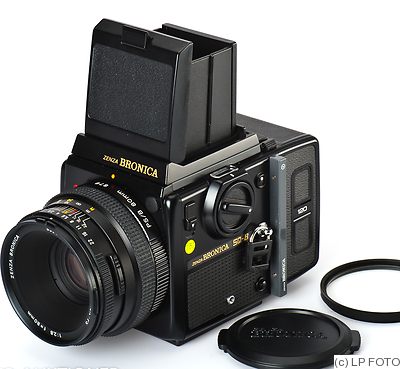


We see another two switches, one for multiple exposures and another one to lock the mirror up – single or continuous. Moving onto the right side, we find another switch (top right), in this case to take the finder off.
#ZENZA BRONICA SQ PC#
Bronica SQ-Ai – Kit (left)Īlso present on this side, cable release socket and PC flash sync that I haven’t used.Īnd finally, on the bottom right of the picture above, a button that releases the film back. Then the shutter speed dial, a very – for some reason – satisfying one to use. Moving to the left side of the camera, you have the switch to take the lens off (top left). Not because it could fire (it won’t if you have the dark slide in), but it will drain the battery if for some reason it gets pressed in a backpack or somewhere like that. You can (and should) lock it when the camera isn’t being used. The front of the camera is very simple, on the bottom right (when you are holding it) is the shutter. This was going to be my first film camera for “serious” use, I wasn’t sure if it was going to work out.īut then, I learned about this Japanese brand that made some medium format cameras similar to the Hasselblads, and they had a few 6×6 cameras that’d fit my budget!Įnter the Bronica SQ-Ai: my favorite camera, ever. Hasselblad: this one seemed to be my dream camera, but it was way too expensive. Not being able to use different lenses, a not very bright finder, a very desatisfying shutter… TLRs: I already had one at home (Rolleiflex) that I didn’t enjoy using. I began what turned out to be a very quick search: there’s nothing in the digital world using a square sensor that I could afford.įilm had to be it, then. Even post-processing the photo would mean you are “wasting” a third of your sensor (16MP 1×1 instead of the 24MP 3×2). Yes, you have a grid that helps a bit, but the stored photo (both RAW and JPEG) was your traditional 3 by 2. You see, my Sony digital camera didn’t support square format natively. These two changes were enough to make me feel very excited about photography again. And I loved the square format.Ĭomposing a square photo isn’t as easy as it might sound or look, and I wasn’t good at it. I tried to do something different to avoid this: first shooting black and white (never shot it before, or at least not thinking in black and white from the beginning but rather converting color photos), and then I started experimenting with different aspect ratios. Just a few months ago, I was happily shooting digital.


 0 kommentar(er)
0 kommentar(er)
